
The Cold Forging Manufacturing Process
The Hot Forging Manufacturing Process
Cost Efficiency in Cold Forging
Cost Efficiency in Hot Forging
The Main Difference Between Cold and Hot Forging
Forging is a manufacturing process, which shapes a solid-phase metal workpiece by applying compressive forces on it. According to the temperature at which it is performed, forging is classified in “hot”, “warm” and “cold”. The machines used to squeeze and deform the material into high strength parts can be divided in the following categories:
- Drop forging machines: forging hammers, screw presses, axial and incremental forging
- Pressure forging machines with translational motion: mechanical and hydraulic presses
- Pressure forging machines with rotational movements: longitudinal and radial rolling mills
- Combination of pressure machines with translational and rotational movements: orbital forging and flospinning
Grain Structure of Forged Components
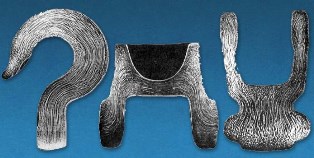 It is essential to note that the forging manufacturing process is completely different from the casting one, where the molten material is poured into a mold. Another significant difference to the other manufacturing methods as casting and machining is that forging improves the mechanical properties of the material by refining its grain structure, providing a good grain flow, and making it tougher and stronger.
It is essential to note that the forging manufacturing process is completely different from the casting one, where the molten material is poured into a mold. Another significant difference to the other manufacturing methods as casting and machining is that forging improves the mechanical properties of the material by refining its grain structure, providing a good grain flow, and making it tougher and stronger.
The Cold Forging Manufacturing Process
The cold forging manufacturing process is performed at room temperature. The workpiece is squeezed between two dies until it has assumed their shape. To deliver a finished, ready to fit component, the technique includes rolling, drawing, pressing, spinning, extruding and heading. Cold forging extrusion is one of the most common manufacturing techniques, widely used in the production of automotive components.
Cold Forged Components
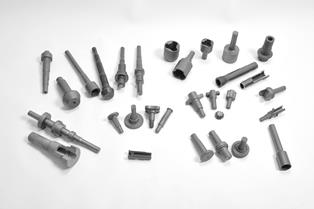
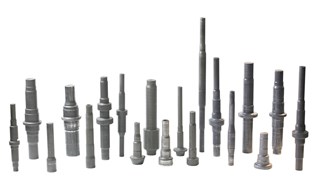
Advantages of Cold Forging
Manufacturers may prefer cold over hot forging process; since cold forged parts require very little or no finishing work. Since all bars are annealed before being forged, there is no need for a secondary heat treatment prior to machining. Another significant advantage is the material savings achieved through near net shapes. The initial weight of the workpiece equals the final weight of the cold forged component. Cold forged parts offer a good level of attainable dimensional accuracy and excellent surface quality.
The economic advantages combined with high production rates and long die life are more than enough to convince many manufacturers that cold forging is the best option for them.
Disadvantages of Cold Forging
Depending on the manufacturer’s requirements, some of the cold forging characteristics may turn out disadvantages; e.g. only simple shapes in high volumes can be shaped. The achievable deformation levels and shaping grade are much more limited compared to stamping. Therefore, if the customer is searching for a specific customized component, cold forging won’t be the best alternative.
A second more significant disadvantage is that cold forged metals are less ductile, which makes them inappropriate for certain configurations. Also, because of the grain structure that gives the material its strength, residual stress may occur.
It is important to mention that cold forging extrusion for example requires also a heat treatment to eliminate possible cracks, creeks hardening or rafters.
As a consequence of the above statements, cold forging cannot be used on every steel grade, particularly on those with low ductility or sensitivity to strain hardening. For instance, low alloy steel with carbon content higher than 0,05% is not appropriate for cold forging.
The Hot Forging Manufacturing Process
The hot forging manufacturing process is performed at extreme high temperature (up to 1150 °C for steel, 360 to 520 °C for al-alloys, 700 to 800 °C for cu-alloys). This temperature is necessary in order to avoid strain hardening of the metal during deformation. Stamping is the most widespread hot forging manufacturing process, where the material is squeezed in a press, between a tool and a die surface.
Hot Forged Components
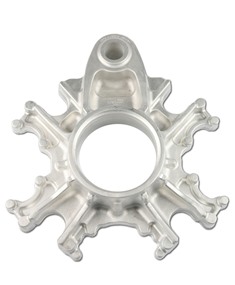
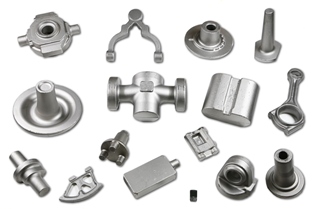
Advantages of Hot Forging
The high temperature during hot forging enables the highest possible level of material deformation and the access to complex 3D geometries. Hot forged components possess increased ductility which makes them desirable for many configurations. Also, as a technique hot forging is more flexible than cold forging, since customized parts can be manufactured.
The excellent surface quality allows a wide range of finishing work as polishing, coating or painting, tailored to customers’ specific need. Hot forging materials are available all over the world which has a positive impact on their final price.
Disadvantages of Hot Forging
The properties of hot forged metals are obtained by subsequent heat treatment, where the material has been quenched to 1000° C and then returned to 500 ° C. This requires additional cost, which can be avoided if using cold forging (except in some cases as softening, annealing or relaxation).
Less precise dimensional tolerance is another possible disadvantage of hot forged components compared to the cold forged ones. The cooling process should be also performed under special conditions; otherwise there is a risk of warping. Also, the grain structure of forged metals may vary and there is always a possibility of reactions between the atmosphere and the workpiece.
The Cost Factor
The manufacturing process is a complex one that can be impacted by many factors as suppliers, equipment, management styles, customers’ demand, etc. The more intense there are, the greater the possibility for disruption in the process and changes in the final price. However, there are 4 important factors that determine the final price of a forged component. These are:
- The amount of the used material;
- Forging costs as electricity, investments, tools, etc;
- Post-forging heat treatments;
- Additional operations as shot blasting or quality control tests.
Cost Efficiency in Cold Forging
Cost optimization in cold forging starts with the raw material. This one can be directly purchased, if necessary, with an included annealing and a peeling, which makes the slugs ready for the process. Since the number of raw materials for cold forging is limited, they are consequently more expensive. To minimize manufacturing cost, cold heading wire is preferred for small pieces.
To obtain best cost efficiency the manufacturing process itself should be managed with an excellent know-how of all involved tools and techniques. For example, large batches of cold extruded components are manufactured on high speed mechanical presses, but complex parts and small series rather on hydraulic presses.
An efficient lubrication system is of critical importance for the successful application of any cold forged part. All workpieces should undergo a zinc-phosphate or polymer coating. Additional lubrication with special forging oil is required on the multi-station presses. A good lubrication system guarantees the high-quality of the final piece and eliminates additional costs for eventual failures during the process.
Cost Efficiency in Hot Forging
The minimization of energy costs during hot forging is an ongoing concern of every manufacturer. Those can be optimized when using an inductor and a billet with matching diameters and installing a flexible multi-stage heating system.
The automatization of all involved forging presses is essential for the cost efficiency of the hot forging manufacturing process, especially for industries that require high volume production runs as the automotive one.
All applied tools should be optimized for the following innovative technologies:
Metallurgy: consolidated vacuum, powder metallurgy
Reloading
Heat treatment
Surface treatment: nitriding, carburizing and duplex treatment
The Main Difference Between Hot and Cold forging
The cold forging manufacturing process increases the strength of a metal through strain hardening at a room temperature. On the contrary the hot forging manufacturing process keeps materials from strain hardening at high temperature, which results in optimum yield strength, low hardness and high ductility.
Finally, a manufacturer would choose one process over the other because of economic and not quality reasons. The decision is based on the required functions of the desired component, the industry and if it’s a mass production or a low volume of customized parts.
Setforge provides cold, warm and hot forging or combination of different processes to address various customer demands, both performed in excellent conditions with state-of-the-art machinery for perfect results. We work close with our customers to understand their specific needs and find the best possible solution.
